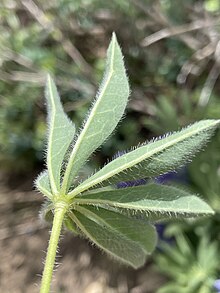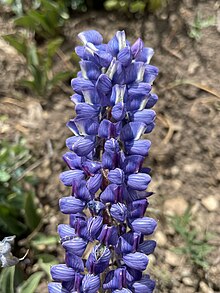| Lupinus prunophilus | |
|---|---|

| |
| Conservation status | |
 Secure (NatureServe) | |
| Scientific classification | |
| Kingdom: | Plantae |
| Clade: | Tracheophytes |
| Clade: | Angiosperms |
| Clade: | Eudicots |
| Clade: | Rosids |
| Order: | Fabales |
| Family: | Fabaceae |
| Subfamily: | Faboideae |
| Genus: | Lupinus |
| Species: | L. prunophilus |
| Binomial name | |
| Lupinus prunophilus M.E.Jones | |
| Synonyms | |
| |
Lupinus prunophilus, commonly known as the hairy bigleaf lupine or chokecherry lupin, is a medium-sized herbaceous plant that grows in the Great Basin and other parts of the U.S. interior between the Sierra-Nevada and the Rockies. It is a close relative and very similar to Lupinus polyphyllus and is considered a subspecies by some botanists.
Description
Lupinus prunophilus is a herbaceous perennial plant that start the growing season with many leaves on short stalks growing from the base of the plant (basal leaves) and retain these leaves as the much taller flowering stem grows and start to bloom. The multiple flowering stems grow outward and then upward (ascending) reaching 23–65 centimeters tall. David B. Dunn described the stems as either slim or somewhat hollow (somewhat fistulose). The stems are sparsely covered in coarse hairs that stand out straight from the stem surface (spreading-hirsute). Both the basal leaves and the flowering stems arise from a woody caudex.

The basal leaves are much more numerous with the 7–30 centimeter long leaf stems (petioles) spreading in every direction to from a rounded tuft of leaves. Each leaf is made up of 8–13 small leaflets, each leaflet is 4–8 centimeters long and rarely less than 10 millimeters wide. The leaflets are flat and much longer than they are wide with the widest portion towards the tip rather than towards the base (oblanceolate). The leaflets are on smaller stalks that are 4–10 centimeters long and attached together at a central point (palmate compound) to the leaf stalk, one of the defining features of genus Lupinus. The leaves are smooth on their upper sides (glabrous) with, at most, only a few hairs on the leaf edges. On the underside they are sparsely covered in fine downy hairs. It has some leaves shorter leaf stalks growing from the flowing stem.

The flowering part of each stalk (the raceme) will have 25–68 flowers and be 6–28 centimeters long. Each flower is 10–16 millimeters long and mainly blue-purple in color, but with a cream or yellow "eyespot" on the banner petal. The upper side of the flower is hairless but will a few fine hairs (ciliate) inside the lower lip also called the keel.
The seed pods will have 4–6 seeds and each seed is 7–11 millimeters wide.
Taxonomy
Though widespread across the western United States, Lupinus prunophilus was not scientifically described and named until 1910. Marcus E. Jones wrote a short, but complete, description in Contributions to Western Botany. However, the Lupinus expert Charles Piper Smith initially thought it was Lupinus wyethii var. prunophilus in 1937. Three years later when he published his comprehensive book about the genus Species Lupinorum he classified it as a subspecies with the name Lupinus arcticus var. prunophilus. Further taxonomic disagreement followed with Lyle Llewellyn Phillips describing it as Lupinus polyphyllus var. prunophilus in 1955. Lewis S. Fleak and David Baxter Dunn published a 1971 paper dividing it between two subspecies, Lupinus bakeri subsp. amplus and Lupinus sericeus subsp. amplus. By 2005 Lupinus prunophilus was either accepted as a subspecies of Lupinus polyphyllus following the classification by Phillips rather than as a subspeices of any of the other Lupinus or classified as a separate species. Though molecular data on a related taxa, Lupinus wyethii, suggest that all of them are part of L. polyphyllus.
As of 2023 the Natural Resources Conservation Service PLANTS database (PLANTS), World Flora Online (WFO), and Plants of the World Online (POWO) all list Lupinus prunophilus as the accepted taxonomic name. However, there is still disagreement with noted botanists such as Jennifer Ackerfield following classifications such as Lupinus polyphyllus var. prunophilus.
Names
Regardless of its correct classification, it is most commonly called the "hairy bigleaf lupin", the for the hairy leaves distinguishing it from the "bigleaf lupin", Lpuinus polyphyllus. Another common name, "chokecherry lupine" referring to the Latin "pronophilus" meaning "choke cherry loving" with the genus Lupinus from Latin "wolfish" from lupus "wolf".
Range
The native range of Lupinus prunophilus is the interior of the western United States including the states of California, Colorado, Idaho, Montana, Nevada, New Mexico, Oregon, Utah, Washington, and Wyoming. In the Southern Rocky Mountains it is rarely found in New Mexico, somewhat more often found in Wyoming, and only frequently found on the Western Slope of Colorado. It is only found in the eastern parts of California, but is found in many places in Nevada and Utah. It grows in eastern Washington state and Oregon and in southern Idaho. There are also a few records of it being found in Montana, but its status there is uncertain.
Lupinus prunophilus was evaluated by NatureServe as globally secure (G5) in 1993. At the state level it was only evaluated in Wyoming, where it was given the status of imperiled (S2).
References
- ^ "'Lupinus prunophilus". Plants of the World Online. Royal Botanic Gardens, Kew. Retrieved 23 July 2023.
- ^ Ackerfield, Jennifer (2022). Flora of Colorado (Second ed.). Fort Worth, Texas: BRIT Press, Fort Worth Botanic Garden, Botanical Research Institute of Texas. pp. 394, 395, 397. ISBN 978-1-889878-89-8.
- ^ Welsh, Stanley L. (30 September 1978). "Utah Flora: Fabaceae (Leguminosae)". The Great Basin Naturalist. 38. M.L. Bean Life Science Museum, Brigham Young University: 330. Retrieved 24 July 2023.
- ^ Dunn, David B. (6 April 1956). Leguminosae of Nevada : Part II. - Lupinus. Beltsville, Maryland: Plant Industry Station. pp. 28–29. Retrieved 23 July 2023.
- Jones, Marcus E. (20 January 1910). "New Species and Notes". Contributions to Western Botany. 13: 7. Retrieved 24 July 2023.
- Wheeler, Erica J.; Edward, Ruthanne L.; Allen, Geraldine A. (April 2005). "Morphological and Molecular Evidence Concerning the Relationship of Lupinus Polyphyllus and L. wyethii (Fabaceae)". Madroño. 52 (2). California Botanical Society: 107. doi:10.3120/0024-9637(2005)52[107:MAMECT]2.0.CO;2. Retrieved 24 July 2023.
- ^ NRCS (23 July 2023), "Lupinus prunophilus", PLANTS Database, United States Department of Agriculture (USDA)
- WFO (2023). "Lupinus prunophilus M.E.Jones". World Flora Online. Retrieved 23 July 2023.
- Schneider, Al. "Lupinus prunophilus". Southwest Colorado Wildflowers. Rocky Mountain Biological Laboratory of Gothic, Colorado. Retrieved 24 July 2023.
- Lewis, Charlton T.; Short, Charles (1879). "lupīnus". A Latin Dictionary. Perseus Digital Library.
- ^ "Lupinus prunophilus M.E.Jones in GBIF Secretariat". GBIF Backbone Taxonomy. Global Biodiversity Information Facility. 2022. doi:10.15468/39omei. Retrieved 25 July 2023.
- NatureServe (2023). "Lupinus prunophilus". NatureServe Explorer. Retrieved 23 July 2023.
| Taxon identifiers | |
|---|---|
| Lupinus prunophilus |
|